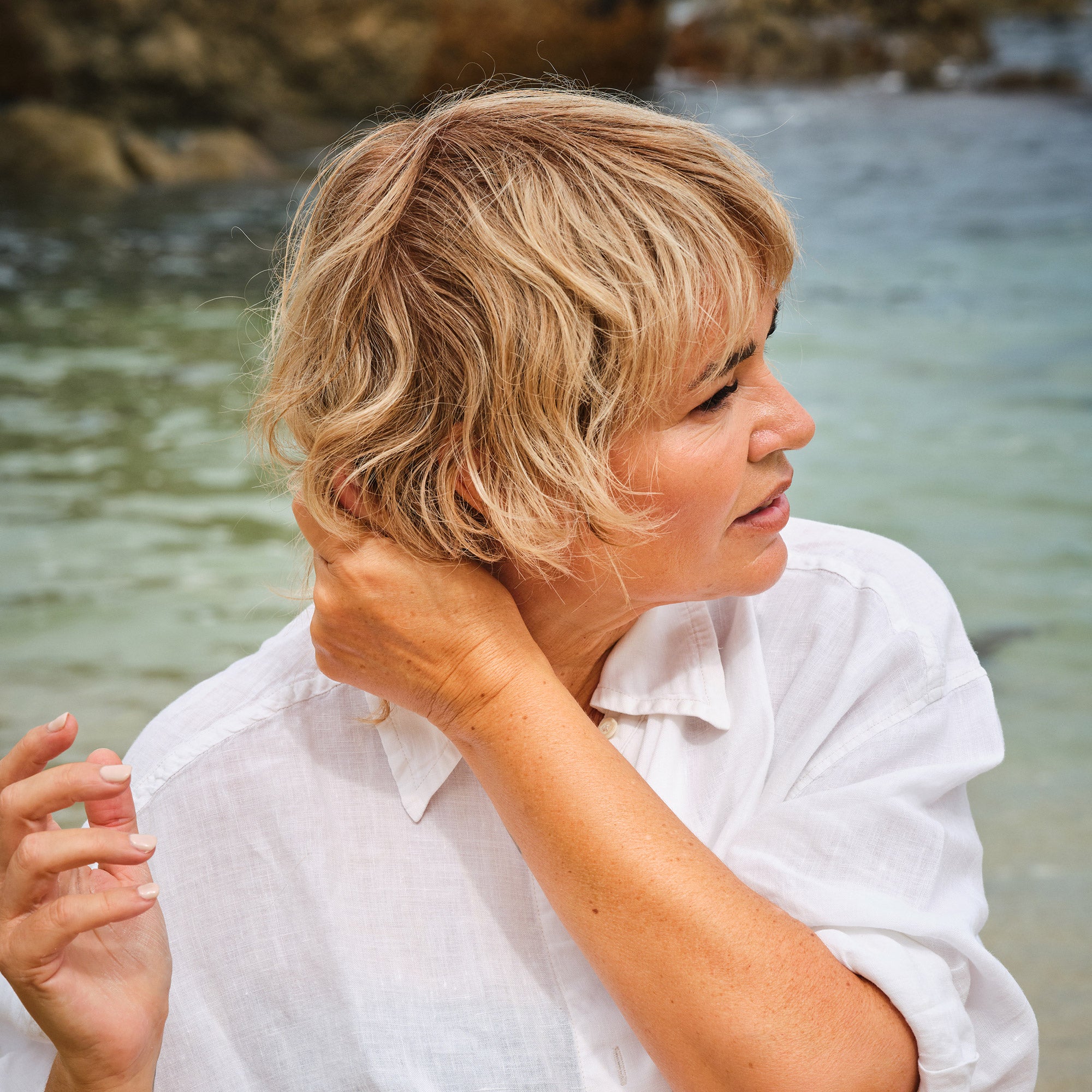Why bleached hair can need a little help
Bleaching hair is a transformative chemical process that can create stunning, lightened looks but can also significantly impact the hair’s structure and moisture balance. The key lies in how bleaching affects the cuticle, the hair's outermost layer.
The cuticle is a protective barrier for the hair’s inner layers, helping it retain moisture and shielding it from external damage. During the bleaching process, the cuticle is lifted to allow the bleach to penetrate and strip the hair’s natural pigment. While this is essential for achieving lighter tones, it also disrupts the cuticle’s function, leaving the hair more porous and vulnerable. As a result, moisture escapes, and the hair can become dry, dull, and brittle.
Bleaching also alters the hair’s texture. Without adequate care, bleached hair often feels rough and dry to the touch, lacking the silky smoothness associated with healthy hair. When the cuticle is damaged or raised, the hair’s outer layer becomes uneven, reducing its ability to reflect light—this is why bleached hair can appear lacklustre.
How does bleach affect your hair?
Bleach is a powerful chemical agent used to lighten hair, but its effects go far beyond just changing the colour. It fundamentally alters the structure of your hair, and understanding how this works can help you make informed decisions about your hair care routine. This is how bleach can affect your hair.
Penetrates the hair shaft
Hair is made up of three layers:
- The Cuticle: The outer layer that protects the inner structures.
- The Cortex: The middle layer where melanin (pigment) resides, giving hair its colour.
- The Medulla: The innermost layer, often absent in fine hair.
When bleach is applied, it lifts the scales of the Cuticle to penetrate into the Cortex. This allows the bleach to break down melanin, effectively removing the natural pigment and creating a lighter shade.
Breaks down proteins
Hair is composed mostly of keratin, a protein that provides strength and structure. Bleach not only removes melanin but also disrupts the protein bonds within the Cortex. This weakening of the hair’s internal structure can lead to:
- Increased fragility and breakage.
- A rougher texture.
- Reduced elasticity, making hair more prone to snapping under tension.
Can change texture
Bleaching strips the hair of its natural oils, leaving it drier and less able to retain moisture. The raised cuticle creates tiny gaps, making it difficult for the hair to lock in hydration. As a result, bleached hair is often brittle and prone to frizz.
The disruption caused by bleach changes the surface of the hair. A healthy cuticle layer lies flat, creating a smooth, reflective surface that contributes to shine. When bleach lifts the cuticle, it leaves the hair rough and uneven, which can make it feel coarse and look dull.
Increases Porosity
Bleached hair becomes more porous, meaning it absorbs and loses moisture more readily. While this can make it easier for the hair to take up additional treatments or colour, it also makes it vulnerable to:
- Environmental factors like humidity and pollution.
- Further damage from heat styling or chemical treatments.
- Fading of toners or colours applied post-bleaching.
Bleach raises the hair's pH, making it more alkaline. This is necessary for the chemical reaction to take place but can leave hair feeling imbalanced. Restoring the pH through acidic products (like conditioners or treatments designed for bleached hair) is essential to maintaining the hair’s health.
How to make bleached hair soft and silky
Achieving soft, silky, and shiny bleached hair requires addressing its moisture imbalance. Hydrating treatments, nourishing products, and consistent care can restore the Cuticle's smoothness and help maintain its protective function. By replenishing moisture and repairing damage, you can enhance bleached hair's overall health and appearance, ensuring it looks vibrant and feels silky to the touch.
The Windle LAB Recovery Regime is an ideal haircare system designed to restore heath and vitality to dry, damaged, or colour treated hair. This regime provides intense hydration and nourishment, aimed at leaving your hair visibility soft, strong and with that all important natural shine.
The regime begins with a nourishing shampoo, a gentle cleanser that effectively removes impurities without stripping away the hair’s natural moisture. This prepares the hair for the next step: the Ultra Nourishing Hair Mask, a luxurious treatment that deeply penetrates the hair shaft to deliver essential nutrients. This mask works to enhance softness, improve manageability, and restore vitality to weakened hair. Finally, the Essential Oils Elixir completes the routine by sealing in moisture, adding a radiant shine, and protecting the hair from environmental stressors.
What sets the Windle LAB Recovery Regime apart is its use of high-quality, natural ingredients. Apricot Kernel Oil, rich in vitamins A and E, nourishes and softens the hair while promoting elasticity and preventing breakage. Coconut Oil is included for its renowned moisturising properties, helping to reduce protein loss and strengthen the hair shaft. Camellia Japonica Seed Oil, a lightweight oil, adds shine and smoothness without leaving the hair feeling heavy.
The formula also incorporates Oat Kernel Oil, which soothes the scalp and delivers extra hydration, improving overall hair health.
Finally, Rosemary Leaf Extract provides antioxidant benefits, stimulating hair growth and enhancing circulation to the scalp. These carefully chosen ingredients work together to repair and revitalise damaged hair, offering a transformative solution for those seeking to restore their hair's natural beauty.
Can You Bleach Grey Hair?
Yes, you can bleach grey hair, but it’s a unique process. Grey hair is often coarser and more chemical-resistant, requiring a slightly stronger formula or additional processing time. Consulting a professional colourist is key to achieving the desired results while minimising damage.
Can Bleaching Cause Hair Loss?
Bleaching itself doesn’t cause hair loss, but excessive or improper bleaching can weaken the hair shaft to the point of breakage. This may give the illusion of hair loss. To prevent this:
- Space out bleaching sessions.
- Avoid overlapping bleach on previously treated hair.
- Use strengthening treatments regularly.
- Always choose a professional hair salon.
Does Chlorine Affect Bleached Hair?
Chlorine can wreak havoc on bleached hair, stripping it of moisture and causing discolouration (think greenish hues). To protect your hair:
- Wear a swim cap when swimming.
- Rinse your hair with clean water before and after swimming.
- Apply a leave-in conditioner as a barrier against chlorine
How to stop bleached hair from fading
Maintaining the vibrancy of bleached hair requires consistent care to prevent fading and brassiness. One of the most effective ways to preserve your hair’s colour is by incorporating specialised products like the Windle LAB Purple Tea Dream Team into your routine. Including our Purple Tea shampoo which has toning properties to keep your hair from dulling, Purple Tea Conditioners that keeps your blondes bright while strengthening your hair, and our Invisible Day and Night Spray, that hydrates and protects your hair.
In addition to using targeted products, there are several other strategies to help keep your bleached hair looking fresh and vibrant.
Reducing how often you wash your hair is also key—washing too frequently can cause colour molecules to fade more quickly. When you wash your hair, rinse it with cool water to seal the hair cuticle and prevent colour from escaping.
Protecting your hair from UV exposure is equally important; ultraviolet rays can degrade hair colour, so wearing hats or using hair products with UV filters is a smart preventative measure.
Additionally, limiting the use of heat styling tools can help maintain colour vibrancy, as excessive heat damages hair and speeds up fading. If you must use heat tools, always apply a heat protectant and stick to lower temperature settings.

Can you wash bleach out of your hair?
Had a change of heart or a hair colour disaster? You might wonder whether bleach can be washed out. The answer is that it cannot. Bleaching is a permanent process that removes the melanin, which gives hair its natural colour.
However, you can dye your hair to match its natural colour. When making a colour change from bleached to another colour, it’s always best to visit a professional salon that can help you transform your colour without incurring further damage to your hair.
Bleached hair can be healthy! With the right care routine and the perfect combination of products, you can maintain strong, vibrant locks even after lightening. If you’re considering a colour transformation, why not choose Windle Salon? Our expert colourists are on hand to advise on the best way to lighten your hair.









